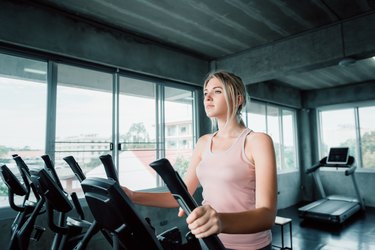
The elliptical trainer provides a low-impact but highly effective way to burn calories. Although this cross trainer primarily targets your leg muscles, many elliptical machines have moving handles to allow your arms to get in on the action.
Read more: Elliptical Machine Benefits
Video of the Day
Video of the Day
Tip
An elliptical trainer targets muscles throughout your legs — hamstring, quads, glutes and calves. However, your arms can often get in on the action.
Hams and Glutes
The hamstrings, located on the back of the legs, perform knee flexion. Leg flexion and extension play a major role in elliptical aerobic exercise. Some elliptical cross-trainer exercise machines have a mechanism that allows you to increase the incline, which simulates hill climbing.
This will cause increased flexion of the legs, providing even greater use of the hamstring muscles. Elliptical machines that allow you to move in reverse will put more emphasis on the hamstrings as they assist with hip extension, or backward movement of your thighs.
The gluteus maximus, also known as the largest of three glute muscles, is actively involved in hip extension. Hip extension is a prime movement in elliptical workouts, especially when the machine is placed at an incline.
Work Your Quads
The quadriceps are a group of four muscles in the front of the thigh. They are activated during knee extension. Since the elliptical machine involves straightening the legs, it works the quadriceps, but don't be surprised if you don't feel them working.
Unlike the stationary bicycle, which puts most of the work in the quadriceps, elliptical machines provide an equally effective workout for the hamstrings, glutes and, in some cases, the upper body. Because the other muscle groups are sharing the load, you are less likely to feel a considerable amount of work in the front of your thighs.
Consider Your Calves
The muscles in your calf — gastrocnemius and soleus — perform plantarflexion. This movement occurs when you press through the ball of your foot against the pedals of the elliptical cross trainer machine. When performed at an incline, your plantarflexors have to work even harder.
Arms, Chest and Back
Some elliptical machines have upper body levers. These machines activate the "pushing" muscles when the arms are straightened. The triceps, found in the back of the arm, and the pectoral muscles, which are the muscles supporting the chest, are considered pushing muscles.
If the elliptical machine has upper body levers, the "pulling muscles" will be activated when the arms are bending. Pulling muscles include the biceps, which are involved in elbow flexion, and the rhomboids, which pull the shoulder blades together in the back. Using the machine in reverse mode puts a greater emphasis on these muscles.
Your Core Contribution
If performed with proper posture, the elliptical machine also strengthens core muscles in your abs and back as they contract to keep you upright and help maintain your balance. Leaning too much weight on the handles of an elliptical machine will decrease involvement of your core muscles.
Was this article helpful?
150 Characters Max
0/150
Thank you for sharing!
Thank you for your feedback!